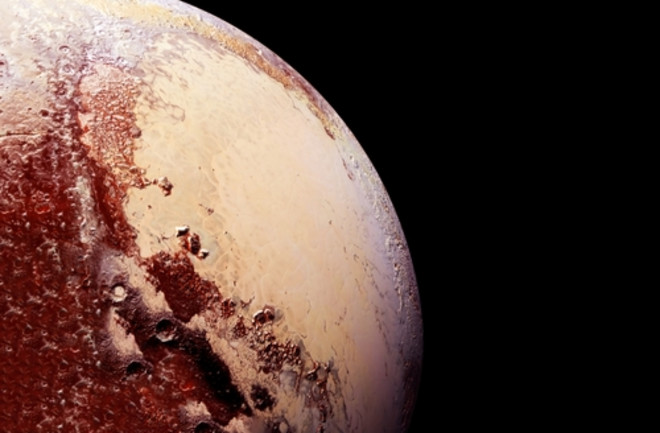When Nasa’s New Horizons spacecraft flew past Pluto in 2015, planetary geologists expected a few dull images of a cold, dark icy body on the edge of the Solar System. But Pluto surprised everyone.
What astronomers discovered was a complex dwarf planet with a surprisingly varied landscape potted with huge cliffs, deep ravines, enormous mountains all battered by a curious kind of weather with evidence of water plus much more.
There is even some evidence of volcanoes on Pluto. These are unlike those on Earth because Pluto is icy rather than rocky with the temperature at a chilly -233 degrees Centigrade. So water ice plays the role of molten rock here and makes Pluto’s eruptions the result of “cryovulcanism”.
But the scale of this volcanic activity has been hard to pin down. Now Dale Cruikshank at the University of Central Florida, and colleagues, who have been analyzing the data from New Horizons, say they have found evidence of a supervolcano on Pluto called Kiladze. And the evidence is that it has been active in the last few million years, relatively recently in geological terms.
Ice Eruptions
Kiladze consists of an icy caldera some 44 kilometers across, surrounded by a rim about three kilometers high. By comparison, the Yellowstone Caldera in the US, one of Earth’s largest, is 70 km by 45 km in size although its edges are long since eroded.
The big challenge for planetary geologists is to determine whether such a feature is caused by vulcanism or by an impact with a meteorite.
One clue is that impact craters generally have a central peak, caused by the splashback after a collision. But Kiladze lacks this feature. “Most of the crater floor is smooth,” say Cruikshank and co.
Another clue comes from the way the crater has collapsed over time, which is reminiscent of supervolcanoes elsewhere in the Solar System. “In many respects, Kiladze resembles large calderas found on Earth and Mars,” say the researchers, pointing to the Yellowstone caldera and various supervolcanoes on Mars. “Notably, the Kiladze feature bears a structural and geologic resemblance to one of these calderas, called Siloe Patera, within the Arabia Terra region [on Mars].”
Supervolcanoes are those that eject around 1000 cubic kilometers or more of material in a single event. Kiladze also fits this criterion. Cruikshank and co calculate the volume of displaced materials from the size of the Kiladze depression, which is about 912 cubic kilometers. So it more or less meets the definition of a supervolcano.
Pluto’s strange weather also gives the team a way to estimate the age of the volcano. Because Pluto’s orbit is highly elliptical, its temperature varies significantly as it orbits the Sun. This constant heating and cooling causes methane ice to sublimate, lifting a hydrocarbon haze into Pluto’s atmosphere.
This eventually falls as a kind of snow, coating the entire planet. Over billions of years this has formed a layer of methane ice many kilometers thick in places.
But Kiladze is unusual because it is formed from ammoniated water ice. Scientists believe there are significant water and ammonia deposits beneath the surface of Pluto and that heating from the warmer, radioactive core, causes them to burst through the surface as volcanoes. Ammonia is quickly broken down by sunlight leaving just ammonia salts, hence the term “ammoniated water”.
Volcanic Competition
Other volcanic sites on Pluto also show similar signs of ammoniated water so its presence at Kiladze is yet another clue to its volcanic origin.
The fact that this ice is still visible at Kiladze means the last eruption must have been relatively recently. Cruikshank and co calculate that its freshness suggests it cannot be more than a few million years old.
All this adds up to a remarkable piece of interplanetary detective work. If Cruikshank and co are correct, Kiladze must be the Solar System’s most distant supervolcano. But it may have some competition for this badge.
In 1989, the Voyager 2 spacecraft observed volcanic plumes from Triton, Neptune’s largest moon so it is possible this strange body is also home to supervolcanoes. But it will be some time before astronomers will know for sure. No missions to Neptune and Triton are planned before the late 2030s.
Ref: Kiladze Caldera: A possible "supervolcano" on Pluto : arxiv.org/abs/2310.10904

